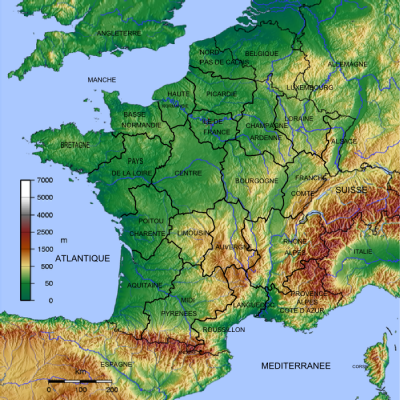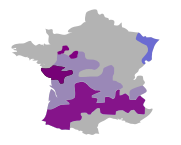
Civil wars decimate France. Continuing our series on France’s Wars. Did you ever notice that in almost every great war in history, France has been involved in some way?
SUMMARY: Together with the Crusades, the civil wars in France and Germany between Catholics and Protestants during the Reformation represent the quintessential religious conflicts. The German wars were largely settled by The Peace of Augsburg in 1555. The French series of conflicts began later lasted until the Edict of Nantes in 1598. The Thirty Years War, the next of the big conflicts, returned to the pattern of religion being more of an excuse beforehand and a propaganda tool during it rather than the actual cause of it and the reason for fighting it.
DURATION: 1562-1598
BACKGROUD: Monopolies have generally delivered more harm than good. The Catholic experience during the Medieval and the Renaissance Ages demonstrated that generality to be true of religion as well as business. Martin Luther tapped into the growing sense of new beginnings of the Renaissance with his protests in Germany in the 1510’s and ‘20’s. The Renaissance Popes, miscalculating the attitudes of the age, dismissed Luther and the growing movement as yet another temporary heresy that would eventually die out or be stamped out. The movement grew from a protest movement to an alternative religion but still within the overall umbrella of Christianity.
Withall, civilization at the time was not yet able to reconcile the situation of religious diversity with national unity. If the two were irreconcilable, then one must be eliminated. The default method for determining that was war.
MAJOR LEADERS
- The Royals
The dates show the years of their reigns.- The Parents
- Henry II (1547-1559) His persecution of the Protestants led to the religious war that followed his death.
- Catherine de’ Medici (died 1589) Held great influence as the Queen Mother. Her policy veered from trying to keep the monarchs clear of the conflict to helping the Catholics win and back again.
- The Children
- Francis II (1559-1560) His mother ran the show and gave the government to the Guise of the Catholic side.
- Charles IX (1560-1574) He presided over the first phases of the war, while trying to appease both sides. The intractable hostility of both sides made him side with the Catholics. His reign showed his indifference to the various massacres, especially the big one on Saint Bartholomew’s Day.
- Henry III (1574-1589) was a moderate in the wars who believed that a strong, authoritarian king who was Catholic but tolerant of Protestants was the way out of the war.
- The Bourbons
Henry IV (1589-1610) was the king who led the Protestants in the final Phase but then declared that “Paris is worth a Mass”, converted to Catholicism, and ended the war.
- The Parents
- The Catholics
- The Dukes of Guise
- Francis (1550-1563) military and political leader with his brother, Cardinal Charles.
- Henry I (1563-1588) formed the Catholic League and led the Catholics in “The War of the Three Henries”.
- Anne, Duke of Montmorency (1551-1567) was a stalwart supporter of the kings of France.
- The Dukes of Guise
- The Protestants aka “Huguenots”
- The Princes of Condé
- Louis de Bourbon, (1557-1569) was an opposition leader to ruling Guise family of Catholics.
- Henri de Bourbon, (1569-1588) not to be confused with Henry of Navarre, he was prominent in the later phases of the war.
- Gaspard de Coligny, (d.1572 in the Saint Bartholomew’s Day Massacre. Aka “Admiral Coligny”.
- The Princes of Condé
- The Royals
The dates given above are the dates of their reigns as either kings, princes, or dukes.

CC BY-SA 4.0 image from Wikipedia.
NARRATIVE: The Hundred Years War was similar to the Wars of Religion in that they both consisted in a series of conflicts interrupted by periods of peace. They differ in that the former was interrupted by truce agreements. while latter conflict was interrupted by peace treaties.
While this legal technicality makes the religion conflict into separate wars, the historical reality makes it one long conflict. I believe that it is easier to understand this conflict by treating it as one long war that is divided into phases. Some of these “wars” did not even consist of military operations but massacres of civilians but are traditionally called “wars” anyway; hence, thinking of them as “phases” of one larger war makes sense.
THE CONFLICT’S PHASES
Phase 1 (1561-1562): After the Massacre of Vassy by the Catholics, Conde seized Orleans. The Huguenots then seized cities up and down the Loire and Rhone Rivers. The Catholics counter attacked. Catherine had the Edict of Amboise issued, ending this Phase.
Phase 2 (1567-1568): After the Huguenots seized La Rochelle and then massacred the Catholics at Nimes, the two sides clashed again at the Battle of Saint-Denis. Another peace agreement was proclaimed along the lines of the Edict of Amboise.
Phase 3 (1568-1570): The Edict of Saint-Maur revoked the Huguenots’ freedom to worship. After narrow win at the Battle of La Roche-l’Abeille, they were badly beaten at the Battle of Moncontour. They regrouped in Toulouse in SW France and then heading east, pillaging as they went. When the army reached the Rhone River, they headed north. Another Royal edict ended the fighting and restored the Huguenot fortunes.Phase 4 (1572-1573): The Saint Bartholomew Day Massacre of the Huguenots by the Catholics precipitated Catholic massacres of Protestants elsewhere in France. Huguenots were supported by the English, the Dutch, and Protestant princes in Germany. This phase ended in a clear Catholic victory with the Edict of Boulogne which severely limited Huguenot freedoms.
Phase 5 (1574-1576): The death of Charles IX triggered another conflict. A large invasion from Germany confronted the new King, Henry III with an overwhelming Protestant coalition. The Edict of Beaulieu gave the Huguenots a big win.
Phase 6 (1576-1577): The Duke of Guise formed Catholic League of Catholic nobles and middle class supporters and opened hostilities. The Edict of Poitiers rescinded most of the previous concessions to the Huguenots.
Phase 7 (1579-1580): With considerable financial help from Spain, the Catholic League triumphed again. The Valois had run out of brothers and under the law of succession, the Protestant Prince Henry of Navarre was the next in line. His right to succeed to the throne was annulled in this war.
Phase 8 (1587-1589): aka “The War of the Three Henrys”, was fought between Henry III of France, Henry the Duke of Guise, and Henry of Navarre. As Henry III lay dying, he begged Navarre to turn Catholic to prevent more bloodshed.
Phase 9 (1589-1593): Henry of Navarre won battles in the field but was unable to take the major cities Paris and Rouen. This prompted him to convert to Catholicism (“Paris is worth a Mass.) and became King IV.
Phase 10 (1595-1598): Spain and the Catholic League continued to oppose the newly Catholic Henry, controlling much of the territory of France. Henry declared war and made progress, though this was now a mixture of national and religious. His Edict of Nantes (1598) mandated religious freedom to both sides. The Treaty of Vendome ended his war with Spain.
AFTERMATH: The Edict of Nantes ended the religious war in France and remained a fundamental law until it was revoked by Louis XIV. The religious warfare in France and elsewhere, affected attitudes down to the end of the millennium.
| <—Previous | Master List | Next—> |
Further Information: here and here and below.
 |
Leave a Reply
You must be logged in to post a comment.